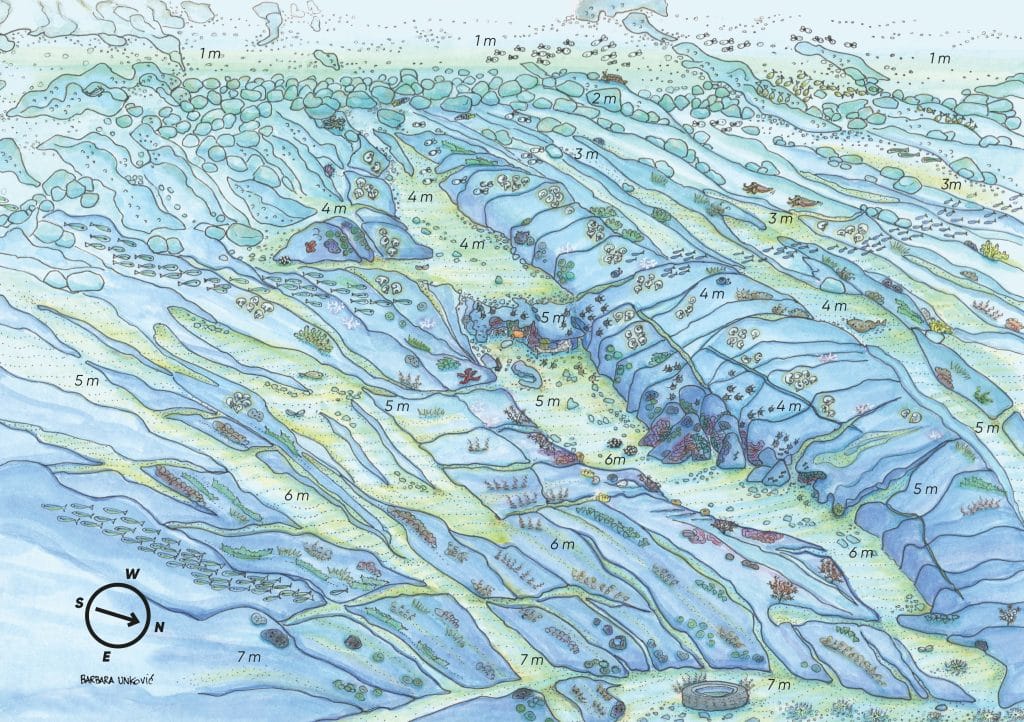RAVNI
The road through the village winds all the way down to the beaches. One can enjoy a beautiful view of the sea passage called Vela vrata offering a view of the city of Rijeka, while across extends the island of Cres. This northern part of the Adriatic Sea is called Kvarner.
Raša is the youngest Istrian town, built during 1936 and 1937 due to the significant mining activity that marked this entire area and left an impressive cultural heritage that is worth further exploration. We will take you to the coast of the Adriatic Sea and the village of Ravni, located at the foot of the eastern slopes of Skitača, and its attractive undersea.
The road through the village winds all the way down to the beaches. One can enjoy a beautiful view of the sea passage called Vela vrata offering a view of the city of Rijeka, while across extends the island of Cres. This northern part of the Adriatic Sea is called Kvarner.
There is a parking lot above the small port, from which a promenade leads you along paved sunbathing areas and small pebbled beaches. A stone wall follows the walkway in a southerly direction. At the point where the wall ends, begins the biggest as well as a dog friendly beach. Where the beach ends, a rocky coast begins, with the rocks that slowly enter the sea – right here you can start exploring this unusual and authentic snorkeling location.
As soon as you enter the sea, you will notice small, round stones that turn into larger boulders. The colour of the sea bottom gradually changes, from light green to golden brown. Somewhat further, at a depth of 2 to 3 meters, the rocky plateau is dotted with sandy, narrow paths of turquoise colour.
One sandy path is the widest, somewhat deeper than the others, slowly descending into depth. It is the main way leading to an interesting step located at a depth of 4 meters. The step has a stone roof, and often provides a cover for the European conger or a catfish that hide under it, depending on the time of year. In case you find them here, don’t be afraid as they are very shy.
The European conger is a snake-like fish, easily recognizable by its black colour. If it sees you, it will go deeper into its home out of fear. During the day, the catfish stays in a hole with only its tail sticking out. Its skin is rough and gray, dotted with black and white spots. It comes out of hiding only at night, when it goes hunting for crabs and cephalopods.
If you can hold your breath a bit longer, be sure to look at the ceiling below the roof. The walls are colorfully painted with various green, dark pink, red and yellow sponges. A frequent inhabitant of the ceiling is also a hairy crab, masked by the orange sponge it carries on its back, given away by the pink teeth on its velvety, brown pincers.
If you continue further, the sandy path will lead you to a small ridge resembling a playful rock garden made of larger boulders colored with red, green and brown algae. Everything around them is full of life. The depth there is 5 to 6 meters, and on the rocky bottom around the sandy path you can see sponge-like sea squirts. You will recognize them by their pinkish orange colour, and a transparent-like appearance. They often grow on other algae as small decorations, resembling orange and white balls.
If you follow the sandy path deeper, it will lead you to an old truck tyre that really has no place here, but has also become someone’s humble home. It is overgrown with algae providing a shelter for a small spider crab, a see cucumber and a hermit crab that wears a yellow-green sea anemones on its shell.
The bottom here is covered with small stones. It is decorated with many golden sea anemones that look like blooming flowers. Their tentacles are light yellow, with pink or purple tips. They usually hide small transparent prawns.
On the way back to the beach, turn to the shallow part, just above the sandy path. There you can find a jelly fungus digging into the sand. Its body is flat, almost oval with a short tail. It is gray with a brownish, marble pattern. It is particularly interesting because of the electric organ it uses to stun its prey and defend itself. It is enough to wave your hand a little above the sand to reveal it. It is not timid and will calmly wait for you to satisfy your curiosity, but do not touch it at all.
Important note
Sea currents in the Raša aquatorium are usually stronger, so be more careful when snorkeling and look towards the shore from time to time so that you always know where you are. If the sea current is taking you away from the shore, swim towards the coast and continue exploring the waters in the opposite direction of the sea current, i.e. against the current.
Because of stronger sea currents and the bora, the northeast wind that often blows in this part of Kvarner, the sea is somewhat colder, but the visibility under it is excellent!
https://www.istra.hr/en/snorkeling


